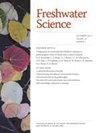Differentiating physical and biological storage of N along an intermittent Antarctic stream corridor
IF 1.6
4区 环境科学与生态学
Q3 ECOLOGY
引用次数: 1
Abstract
In many temperate streams, biological uptake of N acts to attenuate the transport of excess N from allochthonous anthropogenic imports. Relatively few studies have determined how this N uptake relates to the magnitude of physical vs biological N storage in the stream corridor, especially for intermittent systems where allochthonous N imports are often low and N transport may only occur during brief periods of streamflow. Glacial meltwater streams in the McMurdo Dry Valleys of Antarctica provide an excellent setting to quantify autochthonous N-cycling and storage processes supported by abundant algal mats and well-connected hyporheic zones. We combined historic point-scale sediment and periphyton sample datasets with remote sensing-based modeling of periphyton coverage to estimate how much N was stored in periphyton biomass and the hyporheic zone of a 5-km long McMurdo Dry Valley stream corridor (>100,000 m2). We contextualized these N storage calculations by estimating the magnitude of annual N imports to and exports from the stream corridor based on >2 decades of streamflow and surface water data, source glacier ice cores and meltwater data, and past studies of local aeolian deposition and biological N fixation rates. We found that in this highly oligotrophic system, stream corridor-scale N storage was ∼1000× that of total annual N import or export fluxes. More than 90% of this temporarily stored N was autochthonous organic matter in the shallow (<10 cm) hyporheic zone, which acts as a reservoir that sustains N availability in the water column. Despite its location in a polar desert devoid of higher-order vegetation, area-normalized N storage (∼40 g N/m2) was greater than that reported for streams at lower latitudes (∼1–22 g N/m2). We also demonstrated that NH4+ sorption to stream sediment may be an important physicochemical N storage mechanism that responds to short-term fluctuations in streamflow and governs the mobility of inorganic N. Altogether, this research illustrates the importance of quantifying N storage within stream corridors when evaluating the significance of internal cycling and physical retention processes that modulate N availability.沿南极间歇性河流走廊区分氮的物理和生物储存
在许多温带河流中,生物对氮的吸收作用减弱了来自外来人为输入的过量氮的运输。相对较少的研究确定了这种氮吸收与河流廊道中物理和生物氮储存的大小之间的关系,特别是对于间歇性系统,其中异源氮进口通常很低,氮运输可能只发生在短暂的溪流期间。南极洲麦克默多干谷的冰川融水流提供了一个很好的环境来量化原生氮循环和储存过程,这些过程由丰富的藻垫和连接良好的暗水带支持。我们将历史上的点尺度沉积物和周围植物样本数据集与基于遥感的周围植物覆盖模型相结合,估算了5公里长的麦克默多干河谷河流走廊的周围植物生物量和潜流带(bbb10万m2)中储存了多少氮。基于近20年来的河流流量和地表水数据、源冰川冰芯和融水数据,以及过去对当地风成沉积和生物固氮率的研究,我们估算了河流走廊每年输入和输出的氮量,从而将这些氮储存计算纳入背景。我们发现,在这个高度寡营养系统中,河流廊道尺度的氮储量是年总氮输入或输出通量的1000倍。超过90%的临时储存的氮是浅埋带(<10 cm)的原生有机质,这是一个维持水柱中氮有效性的水库。尽管它位于缺乏高阶植被的极地沙漠中,但面积标准化N储存量(~ 40 g N/m2)大于报道的低纬度河流(~ 1-22 g N/m2)。我们还证明了NH4+对河流沉积物的吸附可能是一种重要的物理化学N储存机制,它响应了河流流量的短期波动,并控制了无机N的流动性。总之,本研究说明了在评估调节N有效性的内部循环和物理保留过程的重要性时,量化河流廊道内N储存的重要性。
本文章由计算机程序翻译,如有差异,请以英文原文为准。
求助全文
约1分钟内获得全文
求助全文
来源期刊

Freshwater Science
ECOLOGY-MARINE & FRESHWATER BIOLOGY
CiteScore
4.10
自引率
0.00%
发文量
49
审稿时长
6-12 weeks
期刊介绍:
Freshwater Science (FWS) publishes articles that advance understanding and environmental stewardship of all types of inland aquatic ecosystems (lakes, rivers, streams, reservoirs, subterranean, and estuaries) and ecosystems at the interface between aquatic and terrestrial habitats (wetlands, riparian areas, and floodplains). The journal regularly features papers on a wide range of topics, including physical, chemical, and biological properties of lentic and lotic habitats; ecosystem processes; structure and dynamics of populations, communities, and ecosystems; ecology, systematics, and genetics of freshwater organisms, from bacteria to vertebrates; linkages between freshwater and other ecosystems and between freshwater ecology and other aquatic sciences; bioassessment, conservation, and restoration; environmental management; and new or novel methods for basic or applied research.
 求助内容:
求助内容: 应助结果提醒方式:
应助结果提醒方式:


